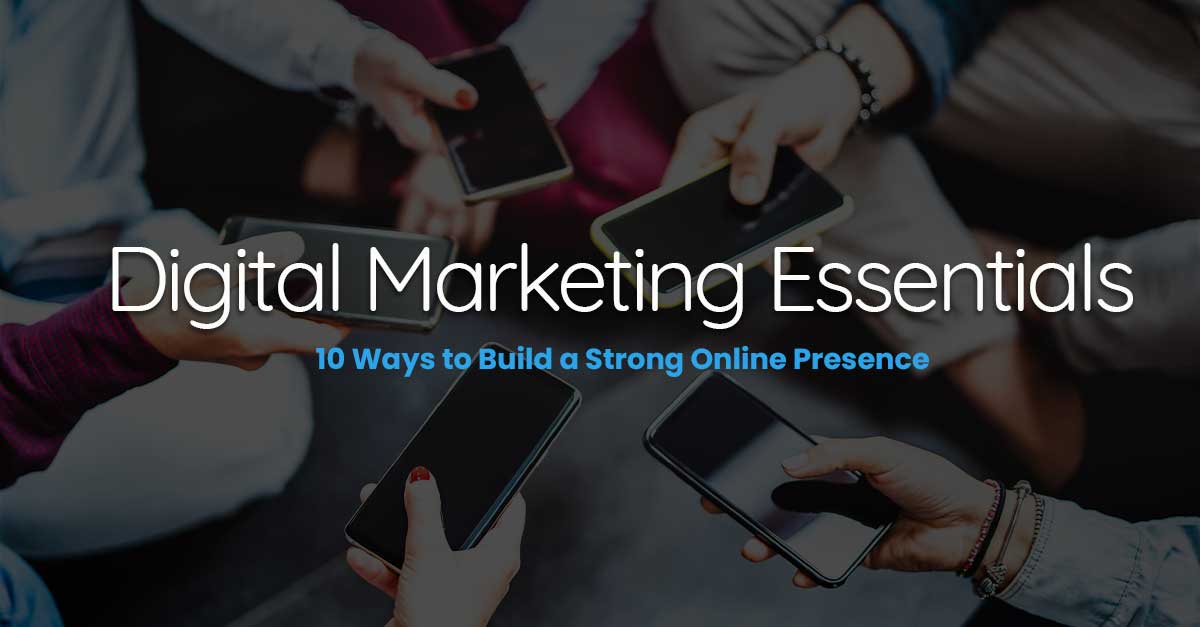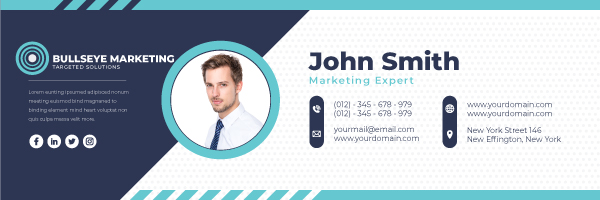
 In today’s ever-evolving digital age, having a strong online presence is crucial for businesses of all sizes. We’ll cover how you can put the right digital marketing strategies in place so you can: Reach and engage your audience, build brand awareness, and drive leads and sales. Let’s dig in and uncover the right elements that you can focus on to can stand out from the crowd.
In today’s ever-evolving digital age, having a strong online presence is crucial for businesses of all sizes. We’ll cover how you can put the right digital marketing strategies in place so you can: Reach and engage your audience, build brand awareness, and drive leads and sales. Let’s dig in and uncover the right elements that you can focus on to can stand out from the crowd.
We’ve also included a handy guide you can download to get started. It covers designing an SEO Strategy, one of the most important aspects to your online presence. Feel free to use it as your guide so you can stay on track with your optimization efforts.
1. Website Design
Your website serves as the virtual storefront for your business. It’s design should be optimized to attract and engage visitors. First, conduct research on your market and generate content that is designed to engage your audience. Next, the interface should be user-friendly, intuitive, and visually appealing. This means your site needs to have a clear navigational structure, responsive design across all devices, fast loading times, and relevant information.
You’ll also want to consider the features your website offers to your visitors. Creating a customer persona is a great place when considering the reason they decided to visit. Are they trying to research something, buy a product, schedule an appointment, request a consultation, request a service, etc.? It’s important to note that your visitors will stay on your website ONLY if find what they’re looking for, see something appealing, or are able to complete a task. It can mean the difference between gaining a customer or having them navigate away.

2. Search Engine Optimization (SEO)
What is SEO?
SEO is the practice of improving your website’s visibility in organic search engine results. This can be done by structuring content effectively, setting up backlinks, and optimizing page speeds.
Keyword Research & Quality Content
When you research your keywords, make sure to review your competitors websites as well. Use keyword variations and incorporate them throughout your website strategically in headings, paragraphs, URL’s, and meta tags. We can’t emphasize enough how important high quality content is to help rank your website. It’s even more important that your content supports your visitors by answering their questions and providing helpful information to fulfill the reason they came to visit in the first place. It’s a win-win all the way around.
Search Engine & Online Directory Listings
Develop a list of information to include on search engine and directory listings and create a complete profile. We recommend populating your listings with your logo, business address, business information, products and/or services, and good imagery. The more information someone can find about your business online that generates a good impression, the better. We recommend to keep things consistent so the same information is found on all of your listings.
Backlinks
Focus on building a strong backlink profile by earning links from reputable and relevant websites. This can be achieved by being listed on a website of organizations you are a member of, setting up profiles on social media outlets and directories, guest blogging, and building relationships with industry influencers.
BlackHat SEO
Avoid using SEO tactics that can hurt your ranking such as:
- Keyword stuffing.
- Inserting hidden text or links.
- Cloaking (showing different content to search engine crawlers).
- Participating in link schemes (buying or selling links from link farms or exchanges).
- Content automation (low quality or auto-generated content that doesn’t provide value to users).
- Filling out false reports on competitors, etc.
There are severe consequences your business and domain could face such as: Being removed or seeing a decrease in ranking, warning messages from search engines on your website results, loss of trust, damage to brand reputation, and you could be dropped by your hosting and/or email provider.
3. Content Marketing
Content marketing involves creating and distributing valuable and relevant content to attract, engage, and retain a target audience. It plays a vital role in establishing your brand as an authority in your industry and driving organic traffic to your website. What’s most important is to develop a content strategy that aligns with your brand and target audience’s needs.
How to Develop a Content Strategy
- Analyze your social media, competitors social media, and website analytics to decipher what content your audience is interested in and engaging with.
- Perform market research on your target audience, demographics, and interests.
- Create a Customer Persona for your target audience and use that to reference when developing content.
- Create a variety of content formats such as blog posts, videos, infographics, and eBooks that surrounds your findings.
- Promote your content through social media, email marketing, and partnerships with other websites or influencers.
BPI Color Marketing Tip: We encourage businesses to plan campaigns each quarter and be at least one month ahead of schedule. This makes it much easier to be prepared and to distribute content without being rushed.
4. Pay-Per-Click Advertising (PPC) & Display Advertising
PPC & Display advertising allows you to display ads on search engines or other websites and pay only when users click on them. It is designed to drive targeted traffic to your website and generate leads quickly, but that is highly dependent on keywords and content. We STRONGLY recommend that you have a plan in place to collect leads, preferably a landing page that will help visitors convert.
Start by conducting thorough keyword research to identify relevant keywords for your ad campaigns. Craft compelling ad copy that entices users to click and include a clear call-to-action. Monitor and optimize your campaigns regularly to improve their performance and maximize your return on investment. An example would be to turn off adds that aren’t performing well, tweaking content and/or landing pages.
BPI Color Marketing Tip: When you sign up for Google Adwords (or other advertising platforms on FB, LinkedIn, Instagram, etc.) most of them will help you get started with your campaign. They will literally walk you through and train you on how to use their platform effectively. You can also look for advertising credits online (usually between $250 – $500) you can claim or check with your hosting provider as they may provide those to their customers.
5. Social Media Marketing
Social media platforms provide powerful opportunities to connect with your target audience and build brand awareness. Choose the social media channels that align with your target audience’s preferences and create engaging content that resonates with them.
Develop a social media strategy that includes a content calendar, consistent branding, and a mix of content. Engage with your audience, respond to comments and messages. We are in a generation that utilizes social media A LOT, this could be the first method they use to get in touch with your business. Lastly, use social media analytics to track and measure your performance.
BPI Color Marketing Tip: Fill out your online profile as thoroughly as possible. Some platforms allow you to sell products and services on your pages. Create more than just a post. Use visual content to tell stories and highlight promotions with videos, slides, and stories. Create interactive content like polls, contests, giveaways, or go live. Focus on standing out instead of blending in.
6. Email Marketing
Nurture Leads
Email marketing allows you to nurture leads, build customer loyalty, and drive conversions. You can build your email list (and retain subscribers) by offering valuable content or incentives for being a subscriber. It is always helpful to give your customers a reason to receive e-mails, but most of all to open them.
Use a Personalized Approach
We also recommend taking a personalized approach to your email campaigns. You can base this on user preferences and behaviors to increase engagement. Next, segment your email list to deliver targeted and relevant content and don’t forget to use compelling subject lines, captivating copy, and clear calls-to-action to drive opens, clicks, and conversions.
Monitor & Redistribute
Lastly, monitor email analytics to gauge the effectiveness of your campaigns and make data-driven decisions. You may also want to consider A/B testing campaigns to see which email performs better. We recommend that you send out another e-mail to non-openers (with the higher performing email if you use an A/B campaign). This helps to improve the number of opens for your email newsletter, rather than just accepting the immediate results.
BPI Color Marketing Tip: You can grow your audience by utilizing e-mail address collection methods in a variety of ways such as:
- Newsletter signup CTA (call to action) on your website and in the footer of your website.
- Sign ups on your social media channels.
- In-store (directly asking customers) upon checkout or rendering services.
- Offering discounts (that can be emailed) that are given for signing up for your newsletter.
- Hosting contests and/or giveaways.
- At trade shows or events your business may represent and attend.

7. Landing Pages
Landing pages can be assigned to your campaigns and are a great way to measure performance and conversions. They can be accessed from posts on social media, email marketing, paid ads, etc.
What’s most important is the effectiveness of your content and page layout. This can be done by utilizing A/B testing to see which page design performs best in terms of bounce rates, time on the page, and conversions. Monitoring can be set up through Google Analytics, server side applications, or on the backend of your website if that feature is available to you.
8. Analytics, Reporting, Tracking & Remarketing
Analytics
Analytics and reporting are essential for measuring the success of your digital marketing efforts. Implement tracking tools like Google Analytics to monitor website traffic, user behavior, and conversions. Set up conversion tracking to measure the effectiveness of your campaigns and identify areas for improvement.
Reporting
Regularly review and analyze your data to gain insights into your audience’s behavior and preferences. Use this information to refine your strategies, optimize your campaigns, and make informed decisions about future initiatives. This data can be found on your social media channels, site analytics plugins on your website, and search engines such as Bing, Yahoo! and Google who provide analytics codes that you can install on your website.
Tracking (and Remarketing)
Tracking pixels, cookies, and scripts are all over the internet. They track things like abandoned carts, page visits, browsing history, etc. These same tools can also remarket advertisements, trigger a pop-up when a user attempts to exit the website, display relevant content to the visitor based on browsing history, keep the user logged in, etc. All of this is an effort to lead the visitor back to the website and hopefully convert as a customer or complete the action being asked of them.
9. Email Address with Your Business Domain Name
Create a professional email address with your business domain name to establish credibility and trust with your audience. Use this email address for all business communications and consider creating multiple addresses for different functions or customer service needs. Don’t rely on free email accounts such as Gmail. They can be thrown into SPAM folders automatically.
10. Email Signature
Include a branded email signature with your contact information, social media links, and a clear call-to-action. This helps to increase brand recognition, drive website traffic, and promote your business in a professional manner.
Putting it all Together
As you can see, there is A LOT that goes into Digital Marketing because it’s a process. Nobody can do these things overnight, but you can build up slowly and get the hang of implementation. Eventually, your plan will be fully rounded out and it will come naturally when it’s time to make adjustments and create new campaigns.
Before we close, we’d like to emphasize one fact about marketing: On average, it takes up to five interactions before a customer acts. When they act really is dependent on your focus and follow through when building and maintaining your online presence. How can they interact five times if your content isn’t reaching them?
Lastly, remember to continuously monitor and optimize your efforts to maximize your return on investment. The key to success in digital marketing is consistency.
























